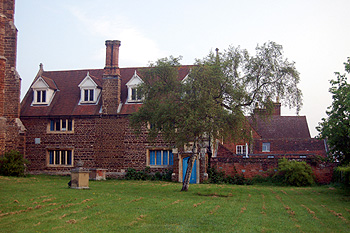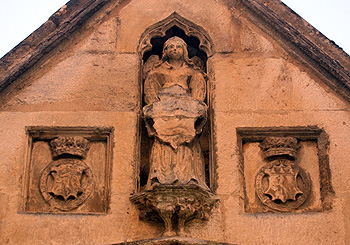Early Education in Woburn

The old school building May 2012
The school was founded by Francis, 2nd Earl of Bedford who, on 5th July 1582 conveyed to trustees a piece of land 58 feet long by 26 feet wide, late in the tenure of John Makant, in Woburn, “on which a house for a free school is erected”, together with the house. “The statutes for the schools at Woborne” were drawn up by the Earl.
The original endowment of the school was £100 “to the end that with the profits thereof a schoolemaster … might have maintenance”. Other people also made bequests to the school: William Stanton of Eversholt in his will of June 1582 gave to the free school “nowe buildinge att Woburne a blacke cowe called Jenkins” [ABP/W1582/60] and Joan Balls of Woburn in November 1587 left twenty shillings a year for two years towards the schoolmaster’s stipend and 13/4 “to the byenge of Scapula his Lexicon to continue and remayne in the Scholehouse of Ooburne for the benefit of Schollers” [ABP/P30/12/1587]. Scapula’s Lexicon was a dictionary of Greek and Latin words. This will was witnessed by Humfrey Hill, schoolmaster.
In 1602 however, the schoolmaster, John Armitage, was writing to Hugh Vaughan a trustee and “chief patron” of Woburn school to complain about the “weake and uncertaine estate of the schoole”, saying that he was finding it difficult to collect the interest on the endowment, and that two yards which had been given to the school by Francis, 2nd Earl of Bedford, and which the school had enjoyed the use of since his time, were in danger of being taken away by the “sinister dealing” of Francis Staunton, late bailiff of the old Countess of Bedford and his brother Thomas. Not surprisingly he left Woburn and was replaced by James Tonge in 1603.
A deed of 1622 states that no interest on the £100 had been paid for many years and that the principal sum was in danger of being lost, so in that year Francis, Lord Russell, imposed a £10 yearly rent charge on the Manor of Woburn for the “maintenance of the said schoole and scholemaster there forever”. The greater part of the £100 endowment had somehow found its way into the hands of Thomas Catesby who died deeply in debt in 1619.
Further references to the schoolmasters of the Free School are to be found in the Woburn parish registers. Under the heading “Buryd of the plague anno domini 1625” is listed James Tong, master of the free school, no doubt the man who had arrived in 1603, with five of his children. Other names which appear are: 1636-1637 William Roberts; 1643 Master Clertherall; 1654 Titus Kidman; 1682 William Lawson (described as a scrivener in his will); 1706 Samuel Knight; 1709 Samuel Davis; 1742 Thomas Thornicraft; 1787 John Foster; 1789 James Shaw and 1798 William Adam.
John Foster evidently was a man endowed with the versatility often expected of village schoolmasters in the eighteenth century. In his will he bequeaths to his son William Foster “my Violin, German Flute, Hautboy and the Bassoon” (if not demanded by the parish), with all Books of Music, a Bible with his name in it, Martin’s Dictionary, “my English Grammars and Arithmetics being Books used in the School and Wing’s Art of Surveying and Slide Rule” [ABP/W1787/13].
Though Francis, Earl of Bedford, had intended the free school to be a grammar school, teaching Latin and Greek in preparation for the universities, by the eighteenth century it had become an ordinary charity school. Accounts in the Russell Archive at Bedfordshire and Luton Archives and Records Service show that from 1706 to 1722 there were thirty boys who were clothed by the Duke at Whitsuntide every year; bills appear for 30 coats, 30 pairs of breeches, 60 shirts, bands, caps, stockings, shoes and buckles. The Duchess seems to have founded a private charity of her own for a school where fifteen charity girls were clothed and taught knitting, sewing and working samplers.
The old school building was listed by the former Ministry of Works in October 1952 as Grade II, of special interest. The listing notes that the original building was reworked around 1830 by Edward Blore. There was also reworking later in the 19th century. The building is constructed of coursed ironstone with ashlar dressings and has a clay tile roof. It is a rectangular structure, formerly consisting of two storeys and attics. The first floor was later removed.

Sculpture on the front of Woburn Lower School May 2012